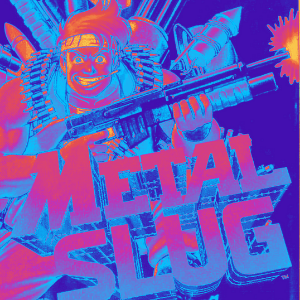Tucked away upstairs a small computer store in Newark were two video game cabinets, among boxed PC games for sale. I was surprised to see them at all given that I was in the current climate where the video game arcade was dying off, though coming from Auckland a mere few months ago and spoiled with the luxury of Yiffans or the gamut of spaces across numerous takeaway shops dotted around the city, it was a bit of a culture shock for me.
I don’t recall what the second cabinet housed, I had a feeling it might have been one of those Operation Wolf style gun games. I damn sure remember what the first cabinet was though; Metal Slug.
[youtube https://www.youtube.com/watch?v=Wl11J6jq4rI&w=560&h=315]
My time spent at United Video (both when it was housed inside part of the video store or when the cabinets were in a concrete room down an alleyway and the more family-friendly area when it moved on the corner of Jasper Avenue) informed me greatly about the works of SNK. I recall pouring coins into the slots when King Of Fighters ’94 made it’s way into the establishment, next to the Tekken cabinet.
Going further back to 1992 when I first ended up in the Auckland Suburb, I was obsessed with the multi-game cabinets where Sengoku, King Of The Monsters and Fatal Fury were all housed in the one cabinet (the Neo-Geo MVS system.) Around that time, a lot of people were ardent Street Fighter: Championship Edition players used to the “revolutionary” six-button system whereas SNK games relied on their traditional four button system. For me, it felt odd having only two punch and two kick buttons but for ease of picking up and playing a game, it made perfect sense – and perhaps this was key for the appeal of those curious to Marco Rossi and his fellow soldiers.

Metal Slug seemed an unusual choice of game to introduce to the world upon its release. At the time, we were beginning to see the rise of 3D polygons pushed more to the forefront of gaming. Virtua Racing begat Daytona USA and Virtua Fighter 2 from the virtuosos at Sega while Namco brought Tekken and Ridge Racer to the table. 2D games were still being made but their interest waned in contrast to graphical advancements in gaming – unless you were a juggernaut such as Capcom or SNK, things got really hard. Even Capcom’s Street Fighter III in retrospect struggled by their own admission – this led to the now iconic series of Alpha/Zero games.
Arcade platformers also were certainly not overly popular at this time either; 2D fighting games still have a lifespan as the fighting game pretty much ruled the world at that time. We were still riding the wave of popularity Street Fighter 2 and Mortal Kombat provided us gamers, while World Heroes 2, Samurai Showdown, Killer Instinct and X-Men: Children Of The Atom became worthy adversaries to the 3D revolution.
SNK’s last attempt at platformer was the beat ’em up Top Hunter – Roddy and Cathy in 1994, which imbued some of its ideas into Metal Slug two years later. SNK’s bread-and-butter were fighting games and shoot-em-ups as the side-scroller seemed to have had its day with the odd dalliance into sports (Super Sidekicks series.) Top Hunter contained analogies that tapped both earlier works and informed later works from the company; the Fatal Fury rail system, where fighters can jump from background to foreground to avoid fights was utilized in the game while the luscious 2D pixel art a forerunner to the bullet hell that would follow two years later.

Metal Slug: Super Vehicle-001 saw it’s arcade release in April 1996 that at times begged for two-players to sink as many coins into the cabinet as possible. With a five-stage scenario, the game had a rather short playthrough that many could finish in thirty minutes, however, within that time a vast amount of credits would be used when first playing through. It helped turn the premise of a “run and gun”, a platformer that emphasised getting through the levels as quick as possible and just blasting anything on the screen, into a more common vernacular in video gaming. From all angles, the characters Marco Rossi and Tarma Roving were attacked by an onslaught of General Morden’s soldiers, tanks, planes, assault helicopters and boats.
It was chaotic in terms of visuals – the fantastic, cartoony 2D animation apparently cost SNK a large amount of money to create that, according to YouTuber Super Bunnyhop in his video on the company, it relied upon the guzzling of coins in order to help cover the costs of its hand-drawn works. The graphics perhaps didn’t boast the stylistic flourishes compared to its 3D peers, but it’s cartoony quality and the sheer glut of what was taking place on the screen became the key to Metal Slug‘s success. It’s home console ports back in the day did see some slowdown in gameplay at it’s most frantic moments, but given its precedent to just bombard the player with bullets, bombs and characters it was almost forgivable.
The ease of picking up Metal Slug‘s control system is another reason it remains a faithful go-to party game. Shoot, jump and grenade – three buttons from SNK’s four-button system as discussed earlier. The player could push the joystick in different directions in order to aim at enemies up above or jump and push down in order to fire at enemies down below… I’m not saying that controls have become convoluted these days because they started to get convoluted back during the game’s arcade release. Where the controls became a convoluted was when the player jumped into one of the tanks, which allowed you to move the direction where the turret fired even if moving in the opposite direction. “Blast away and go go go!” rallied the flyers attached to Metal Slug‘s cabinet; there was no hyperbole with their declaration of intent.
It’s nuances also made the game different to other run and gun games at the time, again thanks to the fantastic animation developers undertook. In one stage, while travelling through a small, invaded village, players could drop down onto the attack boats themselves to lay siege again the enemies if jumping and shooting down became too much of an effort. In another stage, tanks rolled up in the background on small cliffs – the player could shoot the dirt from under the tanks in which said vehicles would plummet and cause damage to anything in its way (including your faithful companion in two player mode.)
It’s a game that begs to be played in co-op mode; levels that give the option of taking the high or low road, the intense amount of enemies that flood the screen at one time and the relative ease to master the controls invites almost anyone to at least try the game out. It’s visuals command your attention, it’s gameplay commands your concentration and it’s difficulty commands your wallet. Had it not of been for the home console versions, Metal Slug might have a GDP by now with how many coins it swallowed. It’s not that it was incredibly hard but rather the frustration of an errant bullet or a frogman with a rocket launcher in a cluttered landscape that caused, in my case, bouts of rage-quitting even in the computer store.
I’ve owned Metal Slug on the PS4 and it’s my go-to game when friends come over for the Sega Saturn. I’ve had countless nights playing Metal Slug among friends who would pass the controller over to the next free individual once they’ve used up their credit – second only to WCW/nWo Revenge when it comes to getting a room full of people to play a game with a rapid turn around. Metal Slug is also one of two games I play with my wife where she is committed to playing it through to the bitter end rather than just humouring me.
Though the series has spawned sequels, remakes and spin-offs, the original still sits with me as a game at the time that not only punched above its weight but knocked out a fair few games with their technological advances also. That’s certainly a testament to how important SNK were (and still are) to video game arcades across the world and their knack of turning something so innocuous into something very enjoyable.






